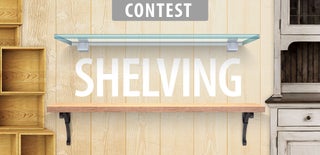Introduction: Reclaimed Wood & Galvanized Pipe Shelves
I re-purposed some old floor joist that were removed during the renovation of a building dating back to the 1890's. I believe that they are Hemlock. I wanted that industrial style incorporated into our kitchen. I contemplated plenty of ideas such as using rope or chain to support the shelves but ultimately decided on galvanized piping for the strength and the fact that the galvanized finish matches the hardware.
Step 1: Materials & Tools
Materials:
Shelving Lumber
Teak Oil
3/4" Galvanized Pipe (or Black Iron pipe sprayed with Galvanized paint to save a few dollars)
(FOUR 3/4" floor flanges; EIGHT 90 degree angles; FOUR tees; SIX 8" threaded pipe; FOUR 10" threaded pipe; TWO 6" threaded pipe; TWO 18" threaded pipe)
16x Flat Wood Screws to attach pipe to wall
Tools:
Wood Chop Box (Miter Saw) or Circular Saw
Drill
7/8" Spade Bit
2" Wire Cup Brush (Fine)
Handheld Wire Brush
Pipe Wrench
Tape Measure
Level
Step 2: Measure and Cut
Find the location you would like your shelves to be, then find center of studs where you will attach the pipe. Now measure from where the edge of the shelf will be, over to your stud locations and write it down. Measure the size you would like the shelves to be, then look over the lumber for the best spots to cut to get the characteristics you would like such as knots, worm holes, and nails and figure out what will be the top and front edges.
I preferred to pull the nails out and cut a foot off the end that had a large crack.
I used a sliding miter saw to make my square cuts.
Step 3: Prep the Wood
To prep the wood, first I used a wide, handheld wire brush to brush all the corners and then the top and bottom of the shelf to knock down the large splintering fibers a bit and to remove the embedded dirt.
The edge that was to be the face had large rust rings from the nails holding on the lathe, and white stripes from the plaster between the lathe. I used a fine wire cup brush in a drill across the whole face. Do not push too hard or it will run off. In the first photo you can see the difference that the wire cup brush made.
For the smooth cut ends, I used the same technique with the drill and wire brush and was pleasantly surprised at the results. The fiber in the wood knocked down pretty fast while the grain remained, giving it a raised grain look.
Last, pulling from the same edge you measured for your studs from, mark your center of where your pipe will land near the face of the shelf. Using one Tee and one 90 degree elbow connected by a length of pipe, of which overall length is less than the depth of the shelf, mark the center location of the tee and make a 1/8 pilot hole. (The tee should be facing the front of the shelf) Duplicate your pilot on the other side.
Vacuum off the shelves.
Note:
Remember when choosing what side to be the top and bottom of your shelf, take into consideration what you will see when they are on the wall. Chances are you may want the BOTTOM of your top shelf to be the better side.
Step 4: Apply the Oil
I poured teak oil onto the wood then used a regular 3/8 nap roller to spread the oil. I did the tops first, stood the shelves on the back edge, to do the face and sides, then rolled it one more time and did the bottom.
The next day I applied a second coat.
Step 5: Adding the Pipe
After the oil finished drying, I drilled out the pilot holes with a 7/8" spade bit drilling half way through, then finishing from the other side to avoid any blowout.
Next I assembled my pipe without the shelves. Try to assemble it so you can use the pipe for leverage as you turn, to keep the pipe wrench use to a minimum. Also, use the pipe wrench wherever it will be covered by the shelf when possible. I put it at the proper height on the wall and marked my top flange. I then leveled the top height across to the other stud. From those marks, I plumbed down to my bottom flange and made a mark. I then attached the pipe to the wall, piloting the screws first so I do not crack the wood.
Then, remove the top flange screws and disassemble down to the first tee.
Step 6: Adding the Shelves
Place the first shelf on the bracket, then thread in the middle section of pipe. If you have a second pair of hands, you can have someone hold the shelf up while you tighten with a pipe wrench where it will be covered. (Threading the pipe first then sliding the shelf over may work, but chances are it will not go as easy as it seems)
Then, install the next section and add the shelf.
Last, thread the top section and secure it back into the original screw holes.
COMPLETE

Participated in the
Shelving Contest 2016









